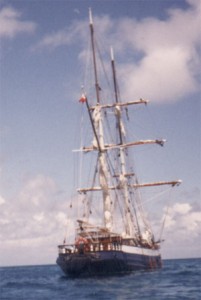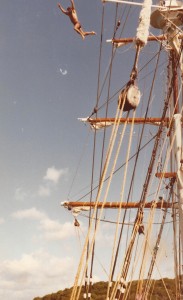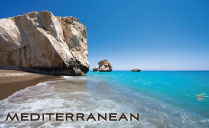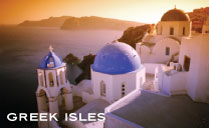Paradise Found by Captain John Borden
Australia’s Whitsunday Islands Part II
20.10 S.Lat / 148.55 E.Lon
 I signed aboard the Golden Plover just in time for her annual haul-out. John DeVere’s Coral Sea Line has its own modest facility on the mainland at Airlie Beach, constructed specifically to handle Plover’s enormous hull. The simple rail and hitch system, however, exposes the keel only at low tide and it takes the coordinated efforts of all crew members, from cook to steward. Everyone participates in the twelve-hour frenzy of cleaning, prepping and painting below the waterline of this 110-foot brigantine. Racing against the tide can create a rather urgent, if not hostile, atmosphere amongst the crew. This is hardly the environment where one would prefer being introduced to one’s new shipmates, that is, if their faces are even discernible through the spattering of the blue bottom paint.
I signed aboard the Golden Plover just in time for her annual haul-out. John DeVere’s Coral Sea Line has its own modest facility on the mainland at Airlie Beach, constructed specifically to handle Plover’s enormous hull. The simple rail and hitch system, however, exposes the keel only at low tide and it takes the coordinated efforts of all crew members, from cook to steward. Everyone participates in the twelve-hour frenzy of cleaning, prepping and painting below the waterline of this 110-foot brigantine. Racing against the tide can create a rather urgent, if not hostile, atmosphere amongst the crew. This is hardly the environment where one would prefer being introduced to one’s new shipmates, that is, if their faces are even discernible through the spattering of the blue bottom paint.
Other than the paint, what initially struck me was the crew’s diversity: male and female; old and young; hailing from Wales, Germany, New Zealand, Sweden, the British Channel Islands and, of course, Australia. I was, in fact, the only “Yank” in the lot. The Golden Plover’s skipper was an Australian nicknamed “Gopher”. While I never completely understood the endearment’s origin, I later learned from one of his lady friends that it stemmed from his having uncommonly large toes. In direct contrast to our boss John DeVere, Gopher, a man of few words, had an easy way about him. The rest of the crew, with the exception of the chefs, engineer and steward, was comprised of wandering, underpaid sailors who, like I, signed aboard for the experience. As first mate, they were under my charge, which immediately caused some dissension. After all, I had only just arrived, while they were old hands, already quite familiar with Plover’s eleven sails and nearly 100 working lines. My position was as much a surprise to me as it was to my crew, and because the Golden Plover is a vacation charter vessel, and not the HMS Bounty, it wasn’t long before we became friends and set about preparing for the next charter, only two days away.
Forty-eight hours is not a long period of time in which to become acquainted with the running gear of a square rigger, her sail commands and the sequence in which they are called. What made matters worse was that John DeVere himself decided to come aboard for the first leg of this charter to check out the new first mate. My fate was in the hands of my crew and I made it abundantly clear they were to cover for me as much as possible.
The Golden Plover was made ready, passengers boarded, and Mr. DeVere took his post, poised next to Gopher at the helm. As we left Airlie Beach and entered the channel, I was as tight as a drum until catching a glimpse of the smug faces of my crew. Almost matter-of-factly, Gopher called to set the fore and aft sails. In response, I cried, “Main staysail, down-haul halyard and sheet! Let go down haul, go halyard and take up the sheet.” It was then that something utterly amazing and unexpected happened. The crew began to sing.
“The village girls on Sunday-haul ‘em away!
They don’t wear any undies-haul ‘em away!
You should see the crew on Monday-haul ‘em away!”
We set the knock staysail, main topmast staysail, inner jib, outer jib, mainsail or “spanker” and then I turned my attention back to the helm for the signal to set the squares. Starting with the forecourse bunt lines, sheets and tacks, the squares were set and trimmed “to the top gallant”. A few rough edges and stammered commands, but, for the most part, things had gone fairly well. It was then that John DeVere turned to the captain and asked if, for the fun of it, we might try to hove to, or come to a dead stop using the sails. This was a maneuver I had done with schooners, ketches, sloops and even yawls, but with a brigantine I didn’t have a clue. On a beam reach, we began tacking the squares.
“No, no, the forecourse looks like a bag of shit,” yelled DeVere as he left the helm and stormed forward. He had me step aside and take notes while the Plover was halted, and was once again allowed to take her course.
As we dropped off Mr. DeVere at Long Island, there were no words exchanged between us. Nothing, however, could begin to diminish what I felt seeing  these islands for the first time. Most of the Whitsunday chain is designated National Park, inhabited primarily by flocks of colorful rainbow parakeets and laughing kookaburras who echo throughout the rain forest. There are even more wonders beneath the sea, where one will find an unparalleled coral community amidst the world’s greatest reef.
these islands for the first time. Most of the Whitsunday chain is designated National Park, inhabited primarily by flocks of colorful rainbow parakeets and laughing kookaburras who echo throughout the rain forest. There are even more wonders beneath the sea, where one will find an unparalleled coral community amidst the world’s greatest reef.
Leaving Long Island and setting sail for Whitsunday, the largest and most beautiful island of this archipelago was a far more relaxing sail. I did become a bit concerned wen the normally reserved Gopher asked everyone to come aft and witness the initiation of the new crew member.
“And what initiation would that be?” I inquired.
He explained that every new crew member who would serve aboard this fine vessel must first climb one hundred feet up the main mast and kiss the capstar atop the mast head. This was easy enough, and afterward, the bar bell was sounded for a round on the house, or ship, as it were.
In reflection, there were quite a few rounds to be had; especially those during happy hour after sails had been unfurled. When Plover was anchored my job as mate finished for the day. Down in the galley, however, things were just warming up where New Zealand Chef David Wilson and his assistant Don (the “kiwis”) were hard at work. I made it a habit of creeping up behind the two with a measure of burgundy and tapping the wine glass twice with a spoon to signal my approach. Dubbing myself “assistant to the assistant cook,” I thoroughly enjoyed helping the understaffed galley crew.
Having seen quite a few gorgeous beaches in my day, White Haven on Whitsunday is easily the most spectacular of them all. This enormous stretch of fine, almost pure white sand is set between crystal water and untouched natural forest. Evening songs and activities on the beach were always a prelude to private walks under the clearest of skies and the brightest of stars, all dancing ‘round the Southern Cross. There is an incredible transparency to Australia’s skies, revealing to me an inspiring phenomenon occurring only once in a man’s life: a phenomenon I could have easily missed. Lying in my sleeping bag on the deck of the Golden Plover, with my naked eye, I actually saw Haley’s Comet-there was absolutely no mistaking it! I was so excited, I woke the entire crew.
 The Aussies have a relentless sense of humor and a great love of sport. In the following months I spent sailing their islands, the antics of the Australian people never ceased to amaze me. In fact, their fun-loving nature brought some things out in me where were better left inside. We were constantly doing things on a bet. For instance, to prove my point once for a few beers at happy hour, I negotiated a standing back flip from the stern rail, abruptly breaking wind at the appropriate juncture. When one of the crew jumped 60 feet from the topsail, I leapt 80 feet from the top gallant, a feat which makes my skin crawl to this day.
The Aussies have a relentless sense of humor and a great love of sport. In the following months I spent sailing their islands, the antics of the Australian people never ceased to amaze me. In fact, their fun-loving nature brought some things out in me where were better left inside. We were constantly doing things on a bet. For instance, to prove my point once for a few beers at happy hour, I negotiated a standing back flip from the stern rail, abruptly breaking wind at the appropriate juncture. When one of the crew jumped 60 feet from the topsail, I leapt 80 feet from the top gallant, a feat which makes my skin crawl to this day.
As first mate aboard the Golden Plover, I learned more about traditional sailing and had more fun than at any time in my life. I was allowed to do things I had only dreamt of as a child. Even John DeVere turned out to be more of a sheep in wolf’s clothing. He was, after all, responsible for my being there. Perhaps I would never have left had I not heard my future wife Carole calling from back in the States. I mean this literally! Returning to the dock at Airlie Beach, I was often first along the key to tie off the dock lines. One day, just as the Golden Plover was secured, the phone rang on the dock at a booth I had never even noticed before. When I picked it up, it was Carole, who had been transferred through the Coral Sea Line office. Some things are far too strange to be mere coincidence.
This story is dedicated to the memory of John DeVere.
The Grenadines: Islands in the Clouds, Part I: The Island of Bequia —>





